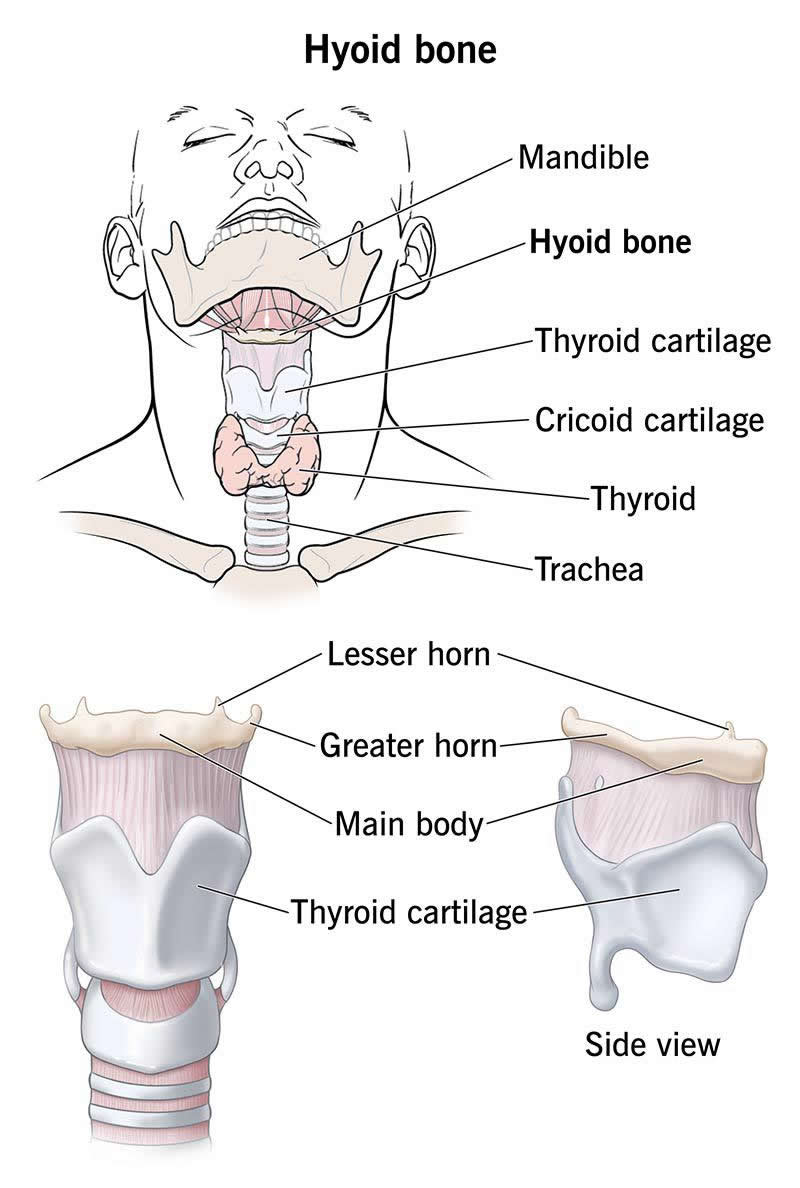Hyoid Bone
Your hyoid bone is in the front of your neck. It supports your tongue and plays a key role in speaking and swallowing. Connected to nearby structures via ligaments, muscles and cartilage, your hyoid bone is the only “floating” bone in your body.
Overview

What is the hyoid bone?
Your hyoid bone is a crescent-shaped bone at the front of your neck. It sits below your lower jaw (mandible) and above your thyroid cartilage (the protective tissue that covers your vocal cords). If you place your fingers where your chin and neck meet and then swallow, you can feel your hyoid bone.
The hyoid bone is special because it’s the only “floating” bone in your body. That means it’s not connected to any other bone. Rather, it’s held in place by ligaments, muscles and cartilage.
Function
What does the hyoid bone do?
Your hyoid bone plays a key role in speaking, swallowing and breathing. It also provides support for several structures around it, like your:
- Tongue.
- Muscles in the floor of your mouth.
- Larynx (voice box).
- Epiglottis.
- Pharynx (throat).
Your hyoid bone is also an attachment point for three main ligaments and several muscles in your neck.
Anatomy
Where is the hyoid bone located?
Your hyoid bone sits at the front of your neck, below your lower jaw and above your thyroid cartilage. If you picture your spine, your hyoid bone “floats” in front of your 4th cervical (neck) vertebrae.
What does the hyoid bone look like?
Your hyoid bone is U-shaped and consists of three parts:
- Main body: The front (and thickest) portion of your hyoid bone. The average hyoid bone body measures about 2.5 centimeters wide by 1 centimeter thick, though it tends to be slightly larger in males.
- Greater horns (greater cornua): The two “arms” of your hyoid bone that make up the sides of the “U.”
- Lesser horns (lesser cornua): Two small bony protrusions near the origin of the greater horns where the stylohyoid ligament attaches.
At birth, a newborn’s hyoid bone consists of three separate bones. During adulthood (usually between the ages of 40 and 60), those bones can fuse into one solid crescent-shaped structure. But for some people, this fusion never takes place. Having an unfused hyoid bone doesn’t mean there’s something wrong, though. It’s just a variation of normal.
Conditions and Disorders
What conditions or disorders affect your hyoid bone?
There are a few health conditions that can affect your hyoid bone, including:
- Hyoid bone syndrome. This condition occurs when there’s inflammation in the muscles and ligaments surrounding your hyoid bone. Causes may include tendonitis, whiplash or other injuries to the area.
- Broken hyoid bone. Fractures of the hyoid bone are rare, making up 0.002% of all broken human bones. Because the hyoid bone hides, tucked away near the junction of your chin and neck, it rarely gets broken. Hyoid fractures most often result from strangulation. They can also result from hangings, gunshot wounds, car accidents and similar traumas.
- Osteoradionecrosis (ORN). This is a serious condition in which bone dies because of radiation exposure. People who receive head and neck radiation therapy have an increased risk. It’s most common in your lower jaw, but it can affect your hyoid bone, too.
- Chondrosarcoma of the hyoid bone (extremely rare cancer). Chondrosarcomas are rare bone cancers that begin in your cartilage. It’s very uncommon to develop this type of cancer in your head and neck. To date, there are only 23 cases of hyoid bone chondrosarcoma mentioned in medical literature. Among people who’ve had this condition, the most common symptom is a slow-growing lump on the neck.
Common symptoms of hyoid bone conditions
Conditions of the hyoid bone may share similar symptoms. Some of the most common include:
- Unexplained facial pain.
- Neck pain.
- Throat pain (chronic pharyngitis).
- Voice disorders.
- Feeling like there’s something stuck in your throat.
- Pain when swallowing.
- Obstructive sleep apnea.
- Bruising.
- A grating sound (crepitus).
- Difficulty speaking.
- Shortness of breath (dyspnea).
- Sores or ulcers in your mouth or throat.
Symptoms of some hyoid bone conditions are similar to those of temporomandibular joint (TMJ) disorders. Because of this, some people get misdiagnosed. If you’ve received treatment for TMJ conditions but you haven’t noticed any improvement, ask your healthcare provider if your hyoid bone might be the culprit.
What imaging tests can help diagnose hyoid bone conditions?
Healthcare providers may use several imaging tests to check the health of your hyoid bone, like:
What are common treatments for hyoid bone conditions?
It depends on which condition you have. But some of the most common treatments include:
- NSAIDs (nonsteroidal anti-inflammatory drugs).
- Antibiotics.
- Steroid injections.
- Analgesic medications.
- Tracheostomy.
- Surgery.
Care
Can I prevent damage to my hyoid bone?
Hyoid bone conditions are rare, and they usually happen due to factors that are out of your control. But if you’re having persistent neck or throat pain, difficulty swallowing or other symptoms mentioned here, talk to your healthcare provider. Early detection and treatment are key.
Additional Common Questions
Is the hyoid bone your Adam’s apple?
No, your Adam’s apple (also called your laryngeal prominence) is part of your thyroid cartilage. Your hyoid bone sits above your thyroid cartilage. Though these structures are near one another, they’re different parts of your anatomy that serve different functions.
A note from Wockr
Your hyoid bone is small, tucked away under your lower jaw, surrounded by protective layers of muscles, ligaments and cartilage. It’s so hidden you probably don’t think about it much — unless it starts to hurt. Hyoid bone conditions are rare. But if you develop hoarseness, shortness of breath, difficulty swallowing or persistent and unexplained pain in your neck or throat, tell your healthcare provider. They can come up with a personalized treatment plan to ease your symptoms and get you back on track.